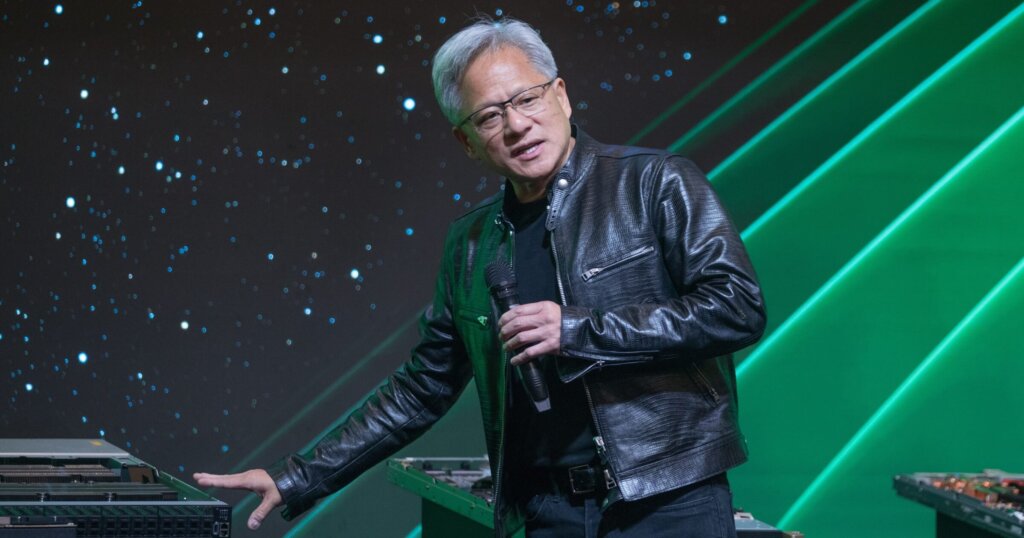Nvidia plans to invest up to $500 billion in U.S.-based production of computer chips and AI supercomputers over the next four years. This move will shift a major portion of Nvidia’s high-performance computing operations back to American soil, with the company working alongside partners like TSMC, Amkor, and Foxconn to build and assemble its next-gen hardware.
The centerpiece of this push is Nvidia’s new Blackwell GPU platform, designed to power cutting-edge AI systems. These supercomputers will be built in the U.S., with components sourced from local or U.S.-based suppliers. Nvidia CEO Jensen Huang called them “AI factories”—a nod to the growing importance of AI infrastructure as a national asset.

Jensen Huang, Nvidia’s Founder and CEO, speaks during a news event in Taipei on June 4, 2024. Photo via Shutterstock
What’s included in the $500 billion investment for AI supercomputers?
Nvidia’s commitment touches every part of the AI hardware pipeline:
- Chip fabrication: TSMC will produce Blackwell GPU chips at its new Arizona fab.
- Packaging: Amkor’s facility in Arizona will package Nvidia chips, with operations starting later in 2024.
- System assembly: Nvidia will assemble AI supercomputers in the U.S. for local deployment.
- Construction spending: Massive capital will go toward building new fabs, packaging facilities, and AI data centers.
Much of the spending will depend on access to CHIPS Act incentives, but Nvidia says it will proceed either way.
What this means for U.S. manufacturing
This is one of the largest private manufacturing investments in U.S. history. For general contractors and design-build firms, it opens the door to a new wave of tech construction projects. These manufacturing plants are highly specialized buildings that require:
- Advanced cooling systems for high-density computing
- Secure server rooms with specialized access and fireproofing
- Massive electrical infrastructure to power racks of GPUs
- Precision-controlled environments for chip packaging and testing
- Sustainable design and energy management for 24/7 operations
For contractors working in MEP, industrial architecture, or mission-critical design, this presents a massive opportunity. The scale and technical demands of Nvidia’s U.S. chip manufacturing build-out are exactly the kind of high-performance environments where expertise matters most. This will create thousands of jobs and provide a much-needed boost to a slumping U.S. manufacturing industry.
Several major players are joining Nvidia in this push to ramp up U.S.-based chip production. Taiwan Semiconductor Manufacturing Company (TSMC) is constructing advanced fabrication plants in Arizona, where it will produce Nvidia’s new Blackwell chips. Right next door, Amkor is setting up a facility to handle advanced chip packaging, making the entire process more streamlined and localized. GlobalFoundries is also on board, partnering with Nvidia to support future chip supply and diversify manufacturing options within the United States. Foxconn, a longtime tech manufacturing giant, is also participating in the effort to expand its presence in Wisconsin to support Nvidia’s AI infrastructure goals.
This shift is happening thanks to the U.S. government backing the effort with subsidies and tax incentives through the CHIPS Act, aiming to boost domestic semiconductor capabilities and reduce the country’s dependence on overseas supply chains. With tensions rising around Taiwan and growing concerns about access to critical components from China, these moves are as much about national security and economic independence as they are about innovation.
These AI supercomputer facilities are expected to be built and expanded through 2029, creating steady demand for contractors for years to come.
To stay ahead of projects like this—where construction meets next-gen tech—subscribe to the Under the Hard Hat newsletter at underthehardhat.org/join-us. You’ll get insider details on where work is booming and what’s coming next.



